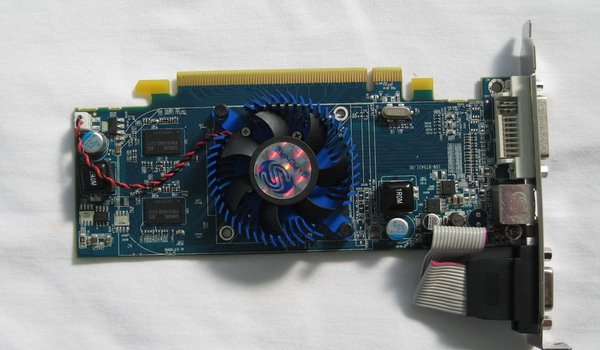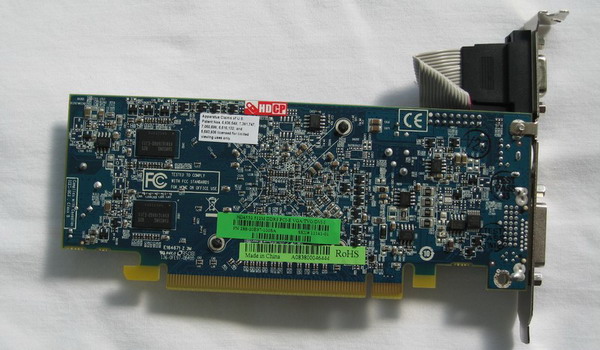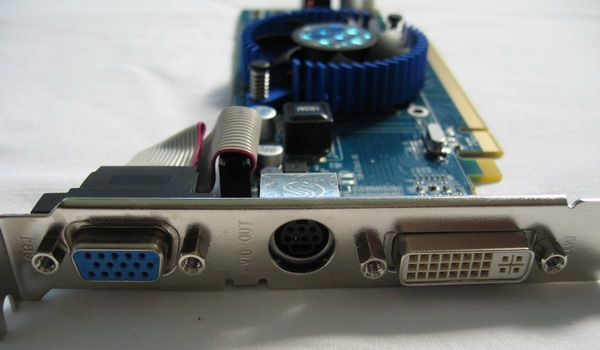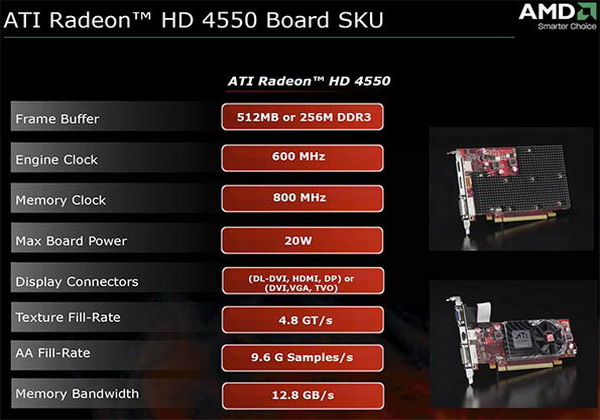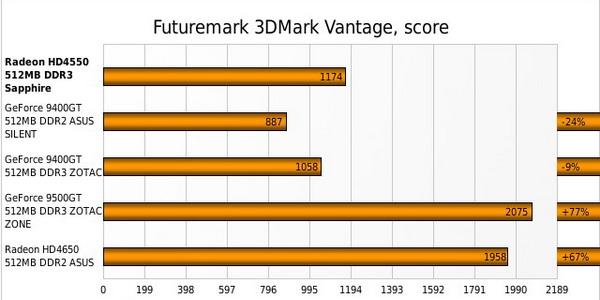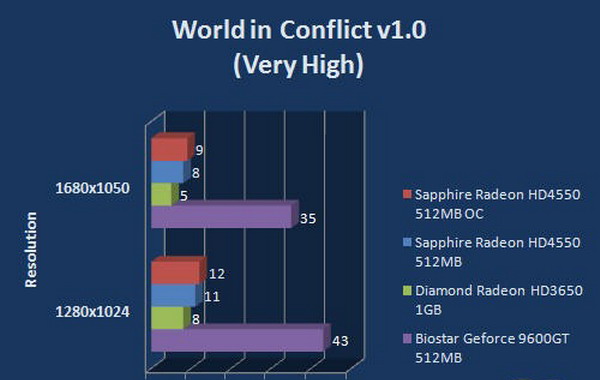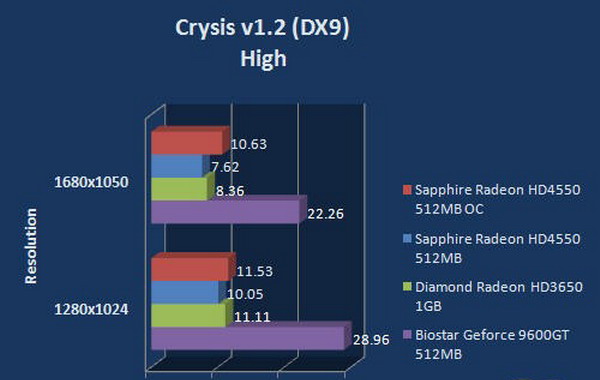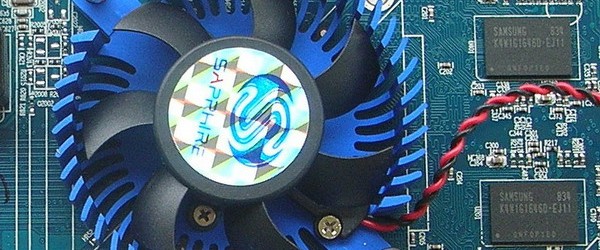
Sapphire Radeon HD 4550 512MB
Hardware 0 CommentsIntroduction
Sometimes a video card needs to be just that. A card for video. Many high-end workstation motherboards don’t have integrated video, but what good is a computer without a display?
The Intel i7 is just the perfect example. A lot of people have the need for quad cores of number-crunching power, but they’re not gamers (we’ll convert you yet, we’ll start slow, like with a relaxing, if hypnotic game of 99 Bricks, followed by a little retro-tastic Gravity Hook. Toss in a few hours of Desktop Tower Defense, and you’re inches away from being neck-deep in Assassin’s Creed) and, appropriately, have no desire to own a beautiful set of GTX 50 millions. (But you’ll get there, we’ll see to that.).
And the Radeon HD 4550 is a perfect example of such a video card. It’s on par with really, really good integrated graphics, and Sapphire’s is half-height (and includes a half-height bracket for the SFF-bound) quiet enough, and consumes about zero watts of power. If that’s your speed, there’s almost nothing you could ever find wrong with an HD 4550. Everyone else, though, move along, nothing to see here.
The Card & Bundle
Like any well-behaved stick of Sapphire hardware, this card has a blue PCB. Unlike damn near any other card on the market, the heatsink is a tiny aluminum disk with brief fins and a fan right in the center. I haven’t seen a fan like this in years, it takes me back. In fact I wonder why this card is actively cooled at all, I’d think a chunky bit of aluminum would be cheaper than a dinky bit and a fan, but then, I don’t make ‘em, I just bench ‘em. Sapphire does, at least, offer a passively-cooled model of this video card.
This short card barely reaches the end of the PCI-Express slot, and is half-height, which means that all you need to do to make it fit in a short case is to swap out the expansion slot bracket for a short one. Good thing there’s one in the box, along with a driver disk, some paperwork, some instructions, a video-out adapter, a VGA adapter, and love.
Specifications and Setup
In this review, we’ll be comparing the Sapphire Radeon HD 4550 to:
- A Radeon HD 3870
- A Sapphire Radeon HD 4670
- A Zotac GeForce 9500 GT
- A Leadtek GeForce 9600 GSO
- A Chaintech GeForce 9600 GT
Test Computer Specifications
- Intel Core 2 Duo E8400 3GHz
- Asus Rampage Formula
- Crucial Ballistix Tracer DDR2 800 @ 4-4-4-12 (Sponsored by Crucial)
- Thermaltake Toughpower 1000 (Sponsored by Thermaltake)
- Windows Vista Ultimate x64 (Sponsored by Microsoft)
Video Card Specifications
“With all the latest features, the ATI Radeon™HD 4550 graphics cards deliver an incredible visual experience with best in classperformance. Enjoy unprecedented levels of graphics realism and play the latest games with support for Microsoft DirectX®10.1. Add this graphics card to your PC and watch Blu-ray movies and HD content play with incredible visual fidelity1, and view digital photos with over 1 billion colors2. Do it all with break-through efficiency that doesn’t compromise performance.”
- ATI Radeon™ HD 4550 — 512MB of DDR3 memory
- DirectX® 10.1
- 80 stream processing units
- 12x custom filter anti-aliasing (CFAA) and high performance anisotropic filtering
- PCI Express® 2.0 support
- Dual mode ATI CrossFireX™ technology multi-GPU support for highly scalable performance
- ATI Avivo™ HD video and display technology
- Unified Video Decoder 2 (UVD 2) for Blu-ray™ and HD Video
- DVD Upscaling & Built-in HDMI with 7.1 surround sound support & Integrated DisplayPort with audio
- Dynamic power management with ATI PowerPlay™ technology
- I/O Output: VGA+DL-DVI-I+HDTV
- Core Clock: 600 MHz & 80 Stream Processors
- Memory Clock: 800MHz, 1800 Mbps.
- PCI Express 2.0 x16 bus interface
- 512MB /64bit DDR3 memory interface
- Single Slot Active Cooler
- HDMI compliant via dongle
- 7.1 Audio Channel Support
- Microsoft® DirectX® 10.1 support
- Shader Model 4.1 support
DirectX 10 Titles
Performance Notes
This card is almost incapable of playing recent titles. Not that it’s intended to.
DX9, OpenGL, and Synthetics
Performance Notes
With older titles, things pick up a little, but are in no way praiseworthy.
Video, Power, and Overclocking
Of course, Sapphire’s HD 4550 has no problems with video playback, as all HD 4000 cards have ATI’s UVD–impressive perfect scores with a very small amount of room for improvement.
This card isn’t silent, you’d have to use a third-party fan control utility to slow down the fan’s speed to that point. But it’s pretty quiet, getting beaten out for noise production by other components of the test bench. For workstations, that’s probably a non-issue, but if you’re interested in this card for video playback (and not gaming) then seek out the fanless version.
Power consumption, on the other hand, is alarming. Alarming good, not alarming bad. This card sets a new record for low power consumption, without compromising on the other features it sets out to perform. That is to say, it drives a monitor, it plays some video, and it consumes almost no electricity.
There are no overclocking options available to this video card in the Catalyst Control Center, but then, what’s the point of that? I think there’s a built-in limit to the speed at which Aero renders.
Conclusion
Like I said, this card delivers. Not on games, though, you’d want to avoid any of that for the welfare of your brain. But it plays video just fine, it’s happy to run a couple of monitors, and it’s half-height with accompanying hardware to fit any size chassis.
But the massively-parallel stream-computing powerhouse just isn’t there. This video card is essentially just integrated graphics for a desktop computer. Which, by its own right, is fine. That’s all some people need, anyway.
This card’s purpose is for workstations to have some way to run a display. If you’re building a home theater PC, this hardware has all the right functions but loses on the aesthetic, just because it has a fan. Fortunately for you, Sapphire also sells one that’s fanless. Just buy that one instead.

